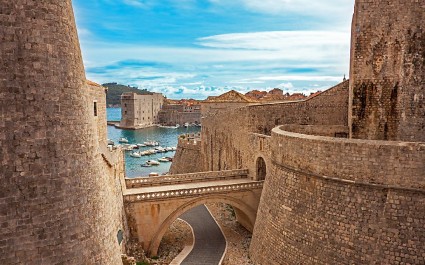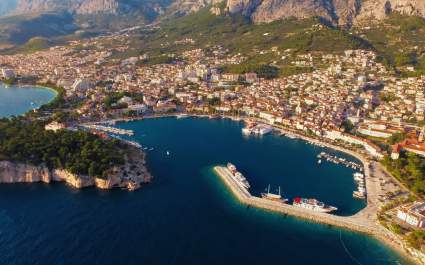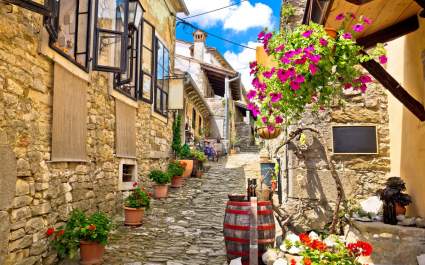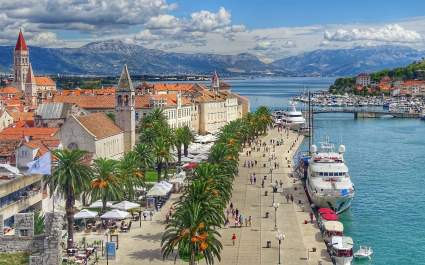Visiting Imotski
A short trip away from the Dalmatian coast you can visit inland Dalmatia, specifically the city of Imotski, which has a particular allure that'll give your trip a touch of wonder. It is a hisoric town, but far from a tourist haunt. Taking a tunnel through Biokovo mountain, Imotski is robbed of a sea view, but it compansates with several breathtaking natural wonders.
So what is there to experience in Imotski?
1. The Red Lake
French cave diver Frederic Swiercynski brought media attention to Imotski when he reached the bottom of this lake. He was the first person in the world to do it and discovered the depth of the lake was 245 meters. Just a few months later, a group of Austrian slackliners walked across this world's third biggest sinkhole, providing a great show and even more media attention.
Crveno Jezero, its Croatian name, is a geological wonder of the Dinaric karst. Carving out underground pits is no small feat and takes eons for the water to dissolve limestone. However, this scientific explanation came long after the folk tales that preceded it. Passed down for centuries, stories about how it originated were all the people of Imotski knew, and they were filled with heroes and heroines, faries and demons, and all kinds of mythical creatures. One such goes a little something like this: A rich, mean and greedy man named Gavan lived by the edge of the Red Lake with his wife. One night, an angel visited them and begged for food and water. They sent him away and the earth collapsed into an abyss, taking Galvan's castle with it.
As you stand over the lake, its mystical beauty will lock you in. Take your time and take it in. They say the lake takes its name after the burning red rocks of the grotto.
2. The Blue Lake
Modro Jezero, as the Croatians call it, is much gentler. You can take in its beauty from high above, or take a stroll down and swim in it. It has a kidney shape and is said to have been two sinkholes that caved in and merged.
The lake, although beautiful in itself, is not the best part about this natural wonder. It is the walk down that will mezmerize you. According to local legend, on the way down you'll reach the 'Fairy's Resting Place,' a place where no human has ever entered, where fairies come out at dusk and dawn.
The best view of the Blue Lake is found from the Imotski Topana Fortress, off of a large cliff. This spot was of strategic importance throughout the long history of Imotski. It was even the center of the Turkish command during the Ottoman invasion (1493-1717), and the border between he two empires when the Venetians took over, marked by a cannon ball fired into the Imotski field.
3. Tin Ujević
When you've had your dose of natural wonders, it is time to take a walk through town. Surrounded by typical Dalmatian stone streets, take a scenic stroll through and you'll arrive at the 'pjaza,' the prettiest one and conveniently completely pedestrianized. Keep going and you'll get to the oldes part of Imotski- 'Bazana', snuggled underneath the Topana fortress. Finally, a little further away, you'll get to 'Skalini,' a staircase from the 18th century that connects Bazana with the newer part of Imotski. At this historic hub you will find the statue of Tin Ujević, one of Croatia's greatest poets, who went to school in Imotski, a connection which the locals are extremely proud of. Their pride grows in the fact that he wrote poems about the sadness he felt leaving Imotski.
Departure
In a hunch, longing for distances, distances;
in the heart, in the breath mountains, mountains. Small places of my heart, recollections of Brac, of Imotski.
And the blaze of a famous mace,
And the smell, the smell of alecost.
There, there if I could travel to,
There, there to grieve;
If I could hear those old fables,
To dream the milk of a blue fairy tale;
Not to know of myself anymore,
or the smokes of pain in the fogs.
Ujević is often called the last Croatian bard. He was a true poetic giant whose verses are filled with both mellow and sombre tones.
4. Vlado Gotovac
Eight kilometers away from the Blue Lake, you will find a unique eco village called Grabovci that celebrates the traditional way of life of the Imotski area. There you will find the Grabovac family farm and its restuarant, which offer a variety of delicacies including roast meat, home grown vegetables, cheese and delicious cakes. Just across the street from the restaunt is the birthplace of Vlado Gotovac, poet and philosopher, a patriod whose love for Croatia cost him over a decade of prison during communism.
Silence the poet
Silence the poet
And the words exchanged will be fewer
— An unexpected radiance rarer
A mysterious reverie more seldom …
Safer the moment will be,
But squandered will be the era …
5. Hasanaginica Thematic Park
Bringing together the rugged nature and tender poetry, alongside the Blue Lake you will find a glass plaque with the following words engraved:
Što se bili u gori zelenoj?
al su snizi, al su labutovi?
da su snizi,
već bi okopnili labutovi već bi poletili:
ni su snizi, nit su labutovi,
nego čator age Asan age.
The poem's english title is 'The Mourning Son of the Noble Wife of the Asan Aga' and to this day it is unknown who wrote it. Regardless, its verses have been recited for generations across the whole Balkans. The story behind the poem goes like this:
Aga is lying wounded in his tent. His mother and sister visit him, but not his wife Hasanaginica. The rules of the society are such. She only obeys them. But wounded and emotional, Aga expects her to break them. And when she doesn’t, he disowns her. Hasanaginica must leave her children and marry another wealthy man. Of course she cannot. And when she sees her children for the last time, she dies of grief.
There have been countless studies of Hasanaginica, to find answers to many questions posed as the ballad’s heartfelt poetry spread all around Europe. It was especially popular during the 18th century Romanticism. Goethe translated it into German, Mérimée into French, Pushkin into Russian and Walter Scott into English. Today it’s available in more than 40 languages.
The plot of the poem takes place near the Blue Lake. And the ruins of the Hasan towers still exist on its southwestern slopes.
Are you now tempted to visit Imotski? You should be. The nature will wow you. But don’t forget the poetry too!




